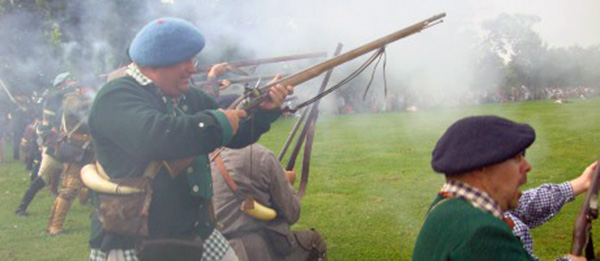Longform nonfiction often answers the question: “Why do those people do that?” Embedded with the Reeanactors by Nick Kowalczyk, posted January 8, 2012 at Salon.com, takes a look at the thousands of Americans who dress up in period costume and re-enact old wars. Kowalczyk not only follows a group of men who re-enact the almost-forgotten French and Indian War, but dressed up himself and takes part in the the battle.

Photo by Salon.com
Kowalczyk’s story has a lot of voice; he doesn’t hold back on his bemusement with the whole thing. Unlike some writers who cover an odd topic with detachment, it’s clear that the exercise strikes him as a bit strange:
It’s not every 4th of July you get to be around nearly 3,000 people inhabiting an amalgam of time, and especially in a place as lovely as Fort Niagara State Park. The water in Lake Ontario actually was blue. And the fortification, now known as Old Fort Niagara, has been well-preserved even though it was built by the French in 1726 and took a 19-day pummeling in July 1759, when a few thousand British and Indians out-maneuvered 600 Frenchman sitting pretty in a big castle protected by cannons and stone walls.
But being on the battlefield exactly 250 years later, I couldn’t help but imagine the 348 people who died and the many others who were injured or suffered. When they trembled for their lives could they ever have imagined that a bloodless, G-rated recreation of their deaths eventually would become someone’s hobby?
The events in the story take place in 2009, not long after the election of Barack Obama, and Kowalczyk shows that the reenactors’ minds are in the present as well. Here, he observes some of their mix of history and modern politics:
“Now that the Democrats are in office they’ll fund every useless social program and gut the things that really matter, like the national parks system.”
Someone else said, “This battle here is the reason today we ain’t speaking French.”
And one re-enactor offered this insight: “We’re people with an appreciation for history. We don’t just take The New York Times and go glug-glug-glug.”
Very few, if any, re-enactors recycled their bottles and cans.
The story drops in a lot of dry humor like that, but remains respectful.
Kowalczyk spends much of the story with “Old Hickory,” a 60-year-old man who usually re-enacts as Andrew Jackson, during his fighting days, before he became the seventh American President. Hickory, a regular who goes to 20 or more reenactments a year, becomes the heart of the story, and through him, we get more personal look at a man who dresses and plays war in his free time. It’s clear that reenacting is his passion and his escape; and Kowalczyk leaves to the reader to determine if this seems depressing:
He bought clothes, a musket, and slept in his car at events. Some considered him “a suit” and “a mooch,” given his white-collar job and healthy diet, his constant requests for help and lack of handyman skills, but he paid those criticisms little mind. At events he was approached by the public, asked questions, even photographed. For the first time in his life he felt appreciated, like he had something to offer the world.
“Now when I’m in my street clothes I don’t feel like that’s my identity,” he said when I once asked him, Who are you outside of this?
In that conversation I drew a circle in my notebook and asked him to fill in the elements of his life — family, hobbies, friends, the job he’d quit, whatever — and to shade in the categories that involved reenacting. The exercise perplexed Old Hickory; he pushed my notebook away. “I don’t need to do that,” he said. “Reenacting is the circle. That’s it. There isn’t anything else anymore.”
This is a fine story, an effective mix of humor and good reporting. It’s entertaining, revealing, and, at times, a little sad.